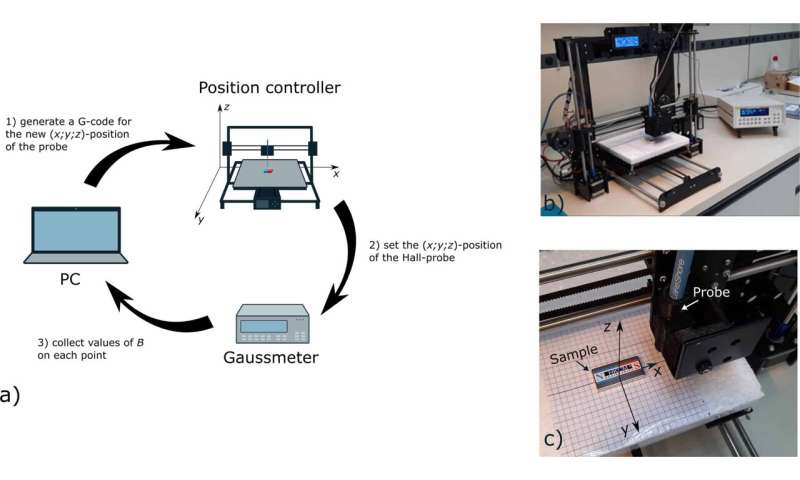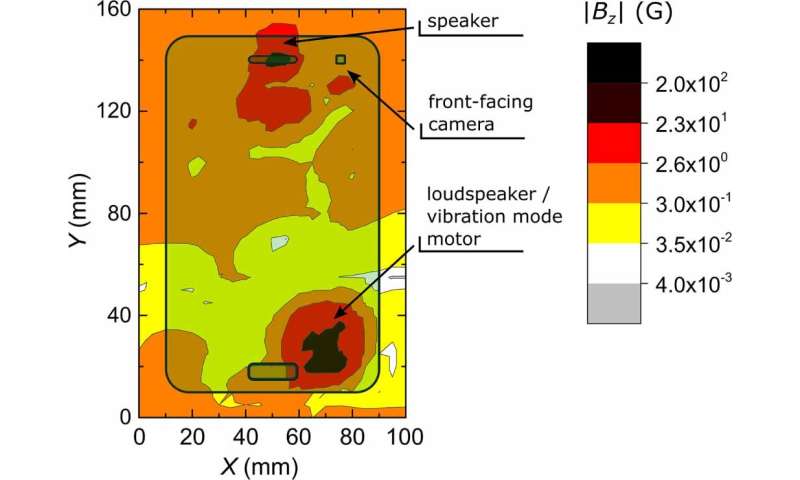Device on the base of 3D-printer helped to make magnetic field maps

Researchers from The Immanuel Kant Baltic Federal University developed a new unexpensive method of magnetic field mapping. Using 3D-printer and common laboratory equipment their team created automatic device, that provides high resolution and at the same time is not expensive as compared to analogic commercial devices. This equipment can map the magnetic field produced by permanent magnets, their arrays and various devices dealing with magnetic field, for example, smartphones and computers. The results of the research are published in journal Measurement Science and Technology.
Many modern electronic devices, including smartphones, computers, medical equipment, and many other things, contain tens of magnetic elements. For these systems to function properly, magnetic fields must have strictly defined characteristics, in particular, intensity and spatial structure. In this connection devices that can precisely estimate features of magnetic fields are highly demanded.
Up to date there exist several kinds of sensors for measurement of magnetic field magnitude, whereby some of them, called a Hall sensors, are rather cheap and compact, so very convenient in use. However, they measure magnetic field magnitude only at a single point. Currently it is difficult to find devices that enable to map spatial structure of magnetic fields. Such devices are rare and quite expensive—approximately several thousand euro.
Researchers from The Immanuel Kant Baltic Federal University (Kaliningrad), University of Genoa (Italy), and University of Oviedo (Spain) build new cheap and easy in constructing device for 3D-mapping of magnetic fields. Authors used the approach often described by expression "do it yourself. They took mechanic part of 3D-printer (the part, that moves and transfers the printing head to the place needed) as the base, attached a Hall sensor to it and elaborated software that automated the process.

The authors evaluated the performance of the device and for tests defined spatial structures of magnetic fields of smartphones, floppy disc and flexible magnet, that had magnetic field only on one of its sides. They programmed in the software a kind of "route", on which a Hall sensor attached to 3D-printer can move and measure the magnitude of magnetic field in every needed point. This resulted in the three-dimensional maps of magnitude of magnetic field for every of analyzed objects.
" Because we used widely accessible on the market components, the suggested approach provides cheap and flexible way of mapping of magnetic fields. It can be easily adapted for various systems and usage, for example, simply by changing a Hall sensor for another one, more suitable for specific work. Going forward, we hope to use this system for testing of the samples that we produce—systems that consisting of several permanent magnets and composite magnetic materials with remnant magnetization",—tells Alexander Omelyanchik, the head of the laboratory of nano- and micromagnetics of the Research and Educational Center "Smart Materials and Biomedical Applications" of The Immanuel Kant Baltic Federal University.
Provided by Immanuel Kant Baltic Federal University